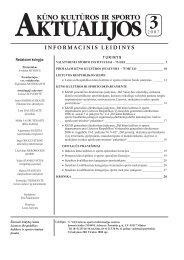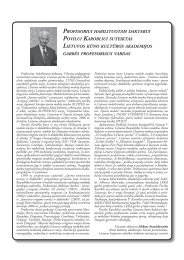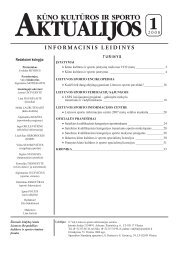Nr. 1 - Lietuvos sporto informacijos centras
Nr. 1 - Lietuvos sporto informacijos centras
Nr. 1 - Lietuvos sporto informacijos centras
Create successful ePaper yourself
Turn your PDF publications into a flip-book with our unique Google optimized e-Paper software.
42<br />
SPORTO MOKSLAS<br />
Morpho-functional changes of young athlete’s<br />
musculoskeletal system<br />
Assoc. Prof. Dr. Jelena Solovjova, Assoc. Prof. Dr. Imants Upitis, Prof. Dr. Juris Grants<br />
Latvian Academy of Sport Education<br />
Summary<br />
In order to study the effect of specific postural changes 59 athletes from three sports, aged 14 through 17 were tested.<br />
Tests were completed using methods by L. Vasiljeva (1996) for visual diagnostics and by V. Janda, 1994, H.Kendall,<br />
F.Kendall, 1982, for muscular functional testing. From these methods a diagnostic program was developed, which<br />
included measuring the changes of 8 sagital points from the vertical plane along with functional testing of 11 muscle<br />
groups. Results showed that falling forward as the standing posture was common to all groups. Hockey players fell<br />
9.1cm (±0.5cm) forward from the vertical plane taken from the ankle, swimmers fell 5.5cm (±0.4cm) while basketball<br />
players fell 10.7cm (±0.6cm) forward. The three groups showed forward tilt of the upper pelvis point. Ice hockey players<br />
had the largest misalignment in the upper pelvis (10.4cm ± 0.7cm), swimmers had the largest misalignment at<br />
the shoulders (10.6cm ± 0.4cm) and basketball players had the largest misalignment at the ears (10.7 ± 0.6cm). It is<br />
believed that an imbalanced training load causes these postural changes in athletes. Functional muscle testing highlighted<br />
changes in the postural muscles of the three groups therefore indicating changes in posture of young athletes.<br />
By using the test data as a base, it should be possible to show early posture changes and to carry out a programme of<br />
prophylaxis and/or correction.<br />
Keywords: young athletes, posture specifics, postural changes.<br />
Introduction<br />
Incorrect posture and muscle imbalance negatively<br />
influence the effectiveness of the training process<br />
(development of technical elements, load increase,<br />
result increase). Significant functional disorders of<br />
the musculoskeletal system decrease the functional<br />
ability of the cardiovascular, respiratory, digestive and<br />
nervous systems, as well as the body adaptation and<br />
vice versa (Travell, Simons 1992; Васильева,1996;<br />
Иваничев 1999).<br />
Optimal statics of the musculoskeletal system<br />
occur when all joint segments are in a neutral position.<br />
Less than optimal body statics is characterized by<br />
asymmetric position of the parts of the musculoskeletal<br />
system with the increase of the postural muscle<br />
gravitation, and the body is in the position of falling<br />
forward, sideward or backward (Travell, Simons,<br />
1992; Vasilyeva, 1996; Иваничев 1999; Vasilyeva,<br />
2002; Solovjova, 2004; Solovjova, Upitis, 2008). In<br />
recent years thanks to the research concerning the<br />
musculoskeletal system, especially basing on the<br />
theory of biomechanics and patho-biomechanics, the<br />
diagnostic principles of the early functional disorders<br />
of the musculoskeletal system and correction<br />
algorithms of different functional disorders have<br />
changed (Vasilyeva, Michailov, 1995; Васильева,<br />
1999; Solovjova, 2004). The aim of this study was<br />
to measure different postural changes across three<br />
sports: swimming, basketball, ice-hockey. It is<br />
expected that the athletes within the sports will have<br />
similar postural changes but between the sports have<br />
different postural changes due to areas of strength<br />
required by each physical activity. In accordance<br />
with К.Левит (1997) we hypothesise that ice-hockey<br />
and basketball players will demonstrate a lowercross<br />
and swimmers will demonstrate an uppercross. Also<br />
by using the test data as a base, it should be possible<br />
to show early posture changes and to carry out a<br />
programme of prophylaxis and/or correction.<br />
Methods<br />
Fifty-nine athletes in Latvia: 20 swimmers, 20 icehockey<br />
players and 19 basketball players aged 14-17<br />
and having different preparation level were examined.<br />
Tests were completed using methods by L. Vasiljeva<br />
(1996) for visual diagnotics and by V. Janda, 1994,<br />
H.Kendall, F.Kendall, 1982, for muscular functional<br />
testing. From these methods a diagnostic program was<br />
developed, which included measuring the changes<br />
of 8 sagital points from the vertical plane along with<br />
functional testing of 11 muscle groups.<br />
Express-diagnostics of posture statics. The<br />
following points were marked on the athlete: the<br />
external ear opening, acromion, radial point, outer<br />
points of the palm, the highest point of the iliac crest,<br />
the trochanter, the upper end of the fibula bone and<br />
outer ankle. The subject stood at a vertical wall. The<br />
distance from the marked point to the vertical wall<br />
on the right and left side was measured.<br />
Stating of the centre of gravity. To state the<br />
athletes’ centre of gravity to the body vertical line,<br />
as well as the deviation of the centre of gravity from<br />
the vertical, the Digital Balance Analyzer (DBA –<br />
Sweden) was used. The testing was done inside
















